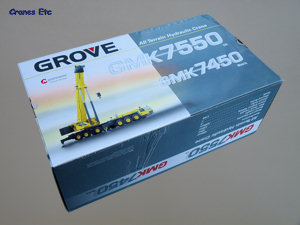 | | The box. |  | 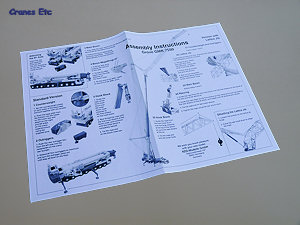 | | Instruction sheet. | 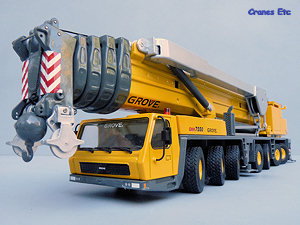 | | Heavy boom. | 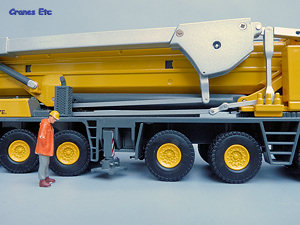 | | Plenty of metal. |
| The GMK 7450 is the largest mobile crane offered by Grove. In Europe it is rated at 450 tonnes hence the model number 7450 whilst in the USA it is rated at 550 US tons and so the model number is 7550.
Packaging
The model is delivered within a large heavy picture box which has technical details listed on the outside. Inside the box are three polystyrene trays, each helpfully labelled with the model number and tray, which hold the various and many parts. Most pieces are also wrapped in protective sheeting. The review model had damage to the crane cab, which appears to have occurred in the factory, and it was replaced by NZG. Also the main boom head had detached from the boom as a result of inadequate gluing and this is understood to be a common problem with this model. However this is easily re-glued or left fitted loosely into the boom if preferred.
A good instruction sheet with photographs is provided, and text is in both English and German. Also supplied is a pair of NZG gloves for preventing finger marks when handling the model.
Detail
Commencing with the crane carrier, the wheels have good tyres with metal hubs although the hubs are all of the same design rather than the different types found on the real machine. Underneath there is relatively little detail but the model is so heavy that looking at the underside will not be a regular occurrence.
The driving cab has windscreen wipers fitted and separate door mirrors are supplied to attach into the holes in the cab. Lights are painted with the exception of a beacon light on the cab roof. Inside the cab the seats and steering wheel are modelled. Just behind the cab the fuel tank and exhaust stacks are rendered well.
The outriggers are each two-stage metal with very good looking metal pads fitted. The crane body is generally excellent. On the right hand side steps, handrails, fuel tank, radiator grille and exhaust all look impressive. The left hand side is plainer as per the original but the casting details are still good. A pair of beacon lights are provided.
The cab is of the swing-away variety. It includes windscreen wipers and metal grab bars and the interior details are good. However there is no indication of any door detail such as handles, which looks a little strange. Also there appears to be a scaling error in that the cab of the review model does not fold back entirely flush in transport mode and so it does not look quite right because it is not fully 'tucked in' at the rear.
The crane body has the luffing winch permanently fixed however it is removable by carefully pushing out the connecting pins and it looks much better in transport mode this way. The pulleys on the luffing unit are metal although they are rather fat. In addition to the main luffing winch there is also a very small winch provided at the rear which is pre-strung however the instructions do not give advice on what it is used for.
The counterweight is held by means of a tray which pins into place and carries five pairs of weights which are secured into position. The weights are cast quite well but the lifting points are not modelled well enough to securely fit lifting chains.
The main boom is impressively heavy looking and consists of a smooth five section telescope. Detail on the first boom section is particularly good and includes a spooling drum on the right hand side. The two main boom lifting cylinders have plastic bodies and pistons and look fine. The boom tip is finely cast with metal pulleys and tiny holes for the fitment of the luffing jib. A dominant feature of the main boom is the Mega Wing Lift system. Almost all parts are metal including the pendant bars and are made finely and hence have delicate components. A point not mentioned in the instructions is that the Mega Wing Lift is pinned to the pendant mechanism during transport, and these pins need to be removed before opening up the system. At the boom tip a pair of excellently detailed side sheaves complete the arrangement.
The main hook block is all metal, has six pulleys and is very well made.
The luffing jib comes in five separate sections and reflects the somewhat unusual Grove design. All lattice work is finely made and the parts fit together well which is an achievement given the fine tolerances employed here. The sections are fastened together using extremely small brass nuts and bolts and fortunately tools are provided to assist with this. It is still a very fiddly task. In fact the parts are so small that it is questionable if they are strong enough when the stresses are high such as when the luffing jib is horizontal or when lifting something, which is a pity as it means it is an act of faith to try displaying the model this way. All pulleys are metal and a single line metal 'headache ball' hook is supplied for use with the luffing jib.
An unfortunate modelling error comes to light when the luffing jib is fixed and the hoist rope is run out to the tip of the jib. It is apparent that a pulley is missing at the hinge point of the luffing mechanism meaning that the rope just runs against the jib lattice in an unsatisfactory way. It is surprising that this error got through the prototyping stage.
Features
Each axle on the model steers independently so any steering combination of the real machine can be replicated. Unfortunately the steering on the front axle fouls the forward bodywork so a hard lock cannot be obtained here.
The outriggers work well with the rear pair supplied as a separate piece which attaches at the rear. This is because the GMK 7450 can be fitted with an optional eighth tag axle and this is provided with the model also. It consists of a separate unit which attaches and locks into position at the rear.
The telescoping sections have a locking mechanism at full extension and the main boom lift cylinders can be pinned at full extension so preventing cylinder bleed when the luffing jib is attached.
The Mega Wing Lift system works well because the two winches are both spring loaded with a locking mechanism so it is possible to tension up the system. The luffing jib also works well although there are few options available for displaying the jib in different configurations because of the design of the original. The model looks good in transport mode and could be accompanied by suitable haulage carrying counterweights and jib sections. Equally, it looks impressive in operating mode particularly if you have the space to show it in the maximum configuration (over two metres high).
Quality
Notwithstanding the manufacturing faults experienced with the review model, this tries to be a high quality piece. The paintwork and lettering are good but in a very few places the paint is less than perfect where it has been damaged during factory assembly. Metal is used where other models often have plastic.
Price
This model is costly for a mass-produced 1:50 scale model however it compares well when it is considered that it also includes a substantial luffing fly jib.
Overall
The GMK 7450 takes the large mobile crane model sector forwards with the attempt at high quality and general attention to detail. It is a pity that there are some issues relating to design and manufacture, as these prevent the model from being regarded as top notch. With that said, it is an impressive addition to the heavy crane model sector. The model looks particularly good in versions painted in hire company liveries.
Footnotes
The model first appeared at the 2004 Nuremberg Toy Fair having been announced the year before. Additional liveries were introduced in the same year: Laukant and Scholpp. In 2005 the model also appeared in Mammoet and Markewitsch colours. In 2007 a version in red Van de Weghe colours was introduced.
|
| |
| 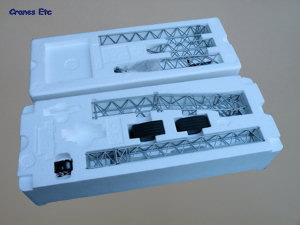 | | Fly jib in two of the trays. | 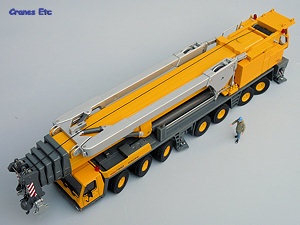 | | Mega Wing lift would have looked better in matching colours. | 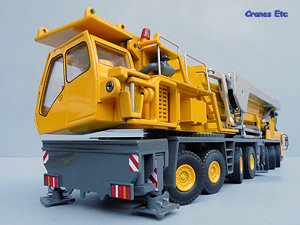 | | Cab tucked in at the rear. |
|

